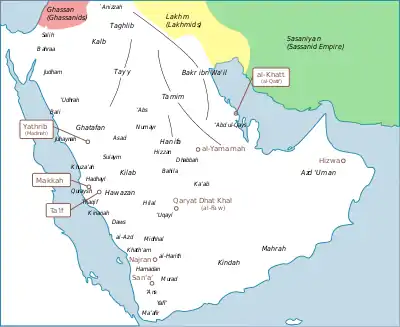Banu Hudhayl
Hudhayl or Hothail or Huthail (Arabic: هذيل) is an Adnanite tribe of western Saudi Arabia in Hijjaz. The tribe is known throughout the history for their talented poets and intellectuals. They are settled mainly in Saudi Arabia and a few thousands in Jordan, Egypt, Tunisia and Morocco.
| Hudhayl هذيل | |
|---|---|
| Adnanites | |
.png.webp) Banner of Banu Hudhayl at the Battle of Siffin | |
| Ethnicity | Arab |
| Nisba | Al-Hudhali |
| Location | Saudi Arabia, Jordan |
| Descended from | Hudhayl ibn Madraka |
| Religion | Paganism, later Islam |
Ancestry
The tribe traces a genealogical history backwards from their eponymous ancestor to Adam:
Hothail son of Madrakah son of Ilyas ( Elijah) son of Madher son of Nazar son of Ma'ad son of Adnan son of Add son of Send son of Napyot[1] son of Ishmael[2][3] son of Abraham[4][5][6] son of Azar[7][8][9] (Terah) son of Nahor[10] son of Srooj[11] son of Ra'o[12] son of Phaleg[13] son of Aber[14] son of Shaleh[15][16][17] son of Arpheckshad[18] son of Sam son of Noah son of Lamek[19] son of Motoshaleh son of Edres (Enoch) son of Yared son of Mehlaiel son of Qenan son of Anosh son of Seth son of Adam
Branches

Banu Huthail are divided in two branches: Lihyan ibn Hothail and Sa'ad ibn Hothail.
Lihyan ibn Hothail
The descendants of Lihyan ibn Hothail who founded the Arab kingdom of Lihyan, and presently live in the desert between Mecca and Ta'if. They are now divided into two clans:
- Mohrez, subdivided into
- Alhosianat
- Aldhban
- Almosah
- Marer, subdivided into
- Albatahah
- Almasaibah
- Alnegimah
- Aloodah
Sa'ad ibn Hothail
There are presently four descendent clans of Sa'ad ibn Hothail:
- Beni, subdivided into
- Banu Omair
- Banu Mas'od
- Banu Mohaiya
- Banu Nobatah
- Fleet, subdivided into
- Alhatareshah
- Alafran
- Al Eyad
- Hothail Albogom
- Banu Reshah
- Almatarefah
- Alsa'iedah
- Almoatan
- Alhatareshah
- Zohair, subdivided into
- AlSrawnah
- Da'ad
- Sahelah
- Zolayfah.
- Jamil, subdivided into
- Alqarh
- Al mahmud
- Alkedwa (also known as Alkedawi)
- Alsawalima
- Alkabakiba
- Beni kaeb
- Bani yas
- Bani zayd
- Banu ziad
- Alhasasana
- Al zalifa
- Alshaeabin
- Altalahat
- Al khalid
- Albaqla
- Al hamid
- Al zaydan
- Sahila
- Aleabida
- Aljawabira
- Alnnjb
Arabian tribes that interacted with Muhammad
Known Members
- Adel Aljubir
- Abdullah bin Masud
- Abou Kacem el Chebbi
Notes
- Book of Genesis 25:12-16
- Ishmael, Encyclopedia of the Qur'an
- Azraqi, Akhbar Makkah, vol. 1, pp. 58-66
- Abraham, Sarah and Hagar Archived 2011-07-25 at the Wayback Machine - James D. Brown
- Genesis 16:1-6
- Qur'an 2:127 to 136
- Qur'an 6:74
- Islamic view of Abraham
- Qur'an 37:99–111
- Luke 3:35
- Book of Genesis11:20-23
- Genesis 11:20
- Genesis 10:25
- Adamic language
- Genesis 10:24
- Genesis 11:12-13
- Luke 3:36
- Book of Genesis 10:22, 24; 11:10-13; 1 Chron. 1:17-18
- Luke 3:37
- Quraish
- Quraysh (sura)
Further reading
- History Ibn Khaldun
- History Ibn al-Athir
- History Ibn Hisham
- History Al-Hamdani
- History Ibn Ishaq
- Kinship and marriage in early Arabia by \ Smith W. Robertson
- A universal history, from the earliest accounts to the present time by \ Universal
- The Koran, Commonly Called the Alcoran of Mohammed by George Sale, Savary
- A Short History of the Arabs by \ Francesco Gabrieli, Salvator Attanasio
- The March from Medina by \ John Walter Jandora
- Muhammad by \ Muhammad Zafrulla Khan
- Mohammed and the Rise of Islam by \ D. S. Margoliouth
- History of Arabia, Ancient and Modern by \ Andrew Crichton
External links
- https://web.archive.org/web/20080316215832/http://www.hathailly.com/vb/showthread.php?t=11324
- http://lahyan.net/vb/archive/index.php/t-24.html%5B%5D
- http://www.tmeme.com/vb/showthread.php?t=342
- https://web.archive.org/web/20080403064904/http://www.thearabhistory.com/mudar
- Arabian tribes that interacted with Muhammad
- http://sirah.al-islam.com/SearchDisp.asp?ID=113&SearchText=هذيل%20بن%20مدركة&SearchType=root&Scope=all&Offset=20&SearchLevel=QBE%5B%5D
- http://sirah.al-islam.com/SearchDisp.asp?ID=1672&SearchText=هذيل%20بن%20مدركة&SearchType=root&Scope=all&Offset=20&SearchLevel=QBE%5B%5D
- https://web.archive.org/web/20100222125145/http://sirah.al-islam.com/tree.asp?ID=1&t=book2
- https://web.archive.org/web/20080309174242/http://sirah.al-islam.com/Display.asp?f=rwd1012
- https://web.archive.org/web/20100122083326/http://sirah.al-islam.com/Display.asp?f=rwd1014
- https://books.google.com/books?id=baw9AAAAIAAJ&pg=PA155&dq=Lihyan&lr=
- https://books.google.com/books?id=CR9iAgUwmTEC&pg=PA338&dq=Lihyan&lr=
- https://books.google.com/books?id=SLvnnT31Du0C&pg=PA230&lpg=PA230&dq=%22Hodhail%22&source=bl&ots=GkklnIdE4X&sig=Kzt-WdMasrCFAZ9jPzm6dC2TGtU&hl=ar&sa=X&oi=book_result&resnum=6&ct=result#PPA230,M1
- http://www.familytreedna.com/public/J1arabproject/default.aspx
- https://web.archive.org/web/20090208095900/http://whitebook.com/p_1_en.htm